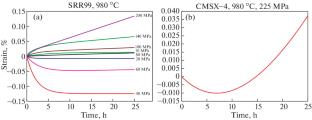镍基超合金单晶的负蠕变
IF 0.6
4区 工程技术
Q4 MECHANICS
引用次数: 0
摘要
研究了两种镍基超级合金单晶体的负蠕变现象。在温度为 980-1000°C 和低加载应力或零加载应力条件下,两种合金都出现了这种现象。据推测,负蠕变的主要原因是基体γ相高度合金化晶格中原子短程有序的形成。影响负蠕变变形的大小和各向异性的其他因素可能是残余应力的松弛:在微观层面--γ-基体和强化γ′-沉淀物之间的错配应力,以及在介观层面--树枝状轴和树枝状区域之间的树枝状应力。本文章由计算机程序翻译,如有差异,请以英文原文为准。

Negative Creep of Single Crystals of Nickel–Based Superalloys
Negative creep of single crystals of two nickel-based superalloys has been studied. This phenomenon was observed for both alloys at temperatures of 980–1000°C and low or zero loading stresses. It is assumed that the main reason for negative creep is the formation of short-range order of atoms in the highly alloyed lattice of the matrix γ-phase. Additional factors influencing the magnitude and anisotropy of negative creep deformation can be the relaxation of residual stresses: at the microscopic level - misfit stresses between the γ-matrix and the strengthening γ′-precipitates, and at the mesoscopic level - dendritic stresses between the dendritic axes and interdendritic regions.
求助全文
通过发布文献求助,成功后即可免费获取论文全文。
去求助
来源期刊

Mechanics of Solids
医学-力学
CiteScore
1.20
自引率
42.90%
发文量
112
审稿时长
6-12 weeks
期刊介绍:
Mechanics of Solids publishes articles in the general areas of dynamics of particles and rigid bodies and the mechanics of deformable solids. The journal has a goal of being a comprehensive record of up-to-the-minute research results. The journal coverage is vibration of discrete and continuous systems; stability and optimization of mechanical systems; automatic control theory; dynamics of multiple body systems; elasticity, viscoelasticity and plasticity; mechanics of composite materials; theory of structures and structural stability; wave propagation and impact of solids; fracture mechanics; micromechanics of solids; mechanics of granular and geological materials; structure-fluid interaction; mechanical behavior of materials; gyroscopes and navigation systems; and nanomechanics. Most of the articles in the journal are theoretical and analytical. They present a blend of basic mechanics theory with analysis of contemporary technological problems.
 求助内容:
求助内容: 应助结果提醒方式:
应助结果提醒方式:


